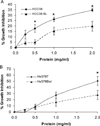Elasmobranch immune cells as a source of novel tumor cell inhibitors: Implications for public health
- PMID: 19343108
- PMCID: PMC2664222
- DOI: 10.1093/icb/icl041
Elasmobranch immune cells as a source of novel tumor cell inhibitors: Implications for public health
Abstract
SYNOPSIS: Reports that elasmobranchs (sharks, skates, and rays) may have a low incidence of disease have stimulated interest in understanding the role of their immune system in this apparent resistance. Although research in this area may potentially translate into applications for human health, a basic understanding of the elasmobranch immune system components and how they function is essential. As in higher vertebrates, elasmobranch fishes possess thymus and spleen, but in the absence of bone marrow and lymph nodes, these fish have evolved unique lymphomyeloid tissues, namely epigonal and Leydig organs. As conditions for short-term culture of elasmobranch immune cells have become better understood, the opportunity to examine functional activity of cytokine-like factors derived from conditioned culture medium has resulted in the identification of growth inhibitory activity against a variety of tumor cell lines. Specifically, the medium enriched by short term culture of bonnethead shark (Sphyrna tiburo) epigonal cells (epigonal conditioned medium, ECM) has been shown to inhibit the growth of mammalian tumor cell lines, including fibrosarcoma (WEHI-164), melanoma (A375.S2), B-cell lymphoma (Daudi), T-cell leukemia (Jurkat), pancreatic cancer (PANC-1), ovarian cancer (NIH:OVCAR-3), and three breast carcinoma cell lines (MCF7, HCC38, Hs578T). Of the cell lines tested, WEHI-164, A375.S2, Daudi, and Jurkat cells were among the most sensitive to growth inhibitory activity of ECM whereas PANC-1 and NIH:OVCAR-3 cells were among the least sensitive. In addition, ECM demonstrated preferential growth inhibition of malignant cells in assays against two different malignant/non-malignant cell line pairs (HCC38/HCC38 BL and Hs 578T/Hs 578Bst). Separation of protein components of ECM using SDS-PAGE resulted in a very reproducible pattern of three major bands corresponding to molecular sizes of approximately 40-42 kD, 24 kD, and 17 kD. Activity is lost after heating at 75 degrees C for 30 min, and can be diminished by treatment with proteinase K and protease. Activity is not affected by treating with trypsin, DNase I or RNase A.
Figures







Similar articles
-
Epigonal conditioned media from bonnethead shark, Sphyrna tiburo, induces apoptosis in a T-cell leukemia cell line, Jurkat E6-1.Mar Drugs. 2013 Aug 26;11(9):3224-57. doi: 10.3390/md11093224. Mar Drugs. 2013. PMID: 24065163 Free PMC article.
-
Molecular identification and functional characteristics of peptide transporters in the bonnethead shark (Sphyrna tiburo).J Comp Physiol B. 2016 Oct;186(7):855-66. doi: 10.1007/s00360-016-0999-8. Epub 2016 May 17. J Comp Physiol B. 2016. PMID: 27188191
-
Synaptology of the olfactory bulb of an elasmobranch fish, Sphyrna tiburo.Anat Embryol (Berl). 1996 Feb;193(2):101-14. doi: 10.1007/BF00214701. Anat Embryol (Berl). 1996. PMID: 8742051
-
Elasmobranch microbiomes: emerging patterns and implications for host health and ecology.Anim Microbiome. 2021 Sep 15;3(1):61. doi: 10.1186/s42523-021-00121-4. Anim Microbiome. 2021. PMID: 34526135 Free PMC article. Review.
-
Comparative study of cartilaginous fish divulges insights into the early evolution of primary, secondary and mucosal lymphoid tissue architecture.Fish Shellfish Immunol. 2020 Dec;107(Pt B):435-443. doi: 10.1016/j.fsi.2020.11.006. Epub 2020 Nov 5. Fish Shellfish Immunol. 2020. PMID: 33161090 Review.
Cited by
-
Demographic processes underlying subtle patterns of population structure in the scalloped hammerhead shark, Sphyrna lewini.PLoS One. 2011;6(7):e21459. doi: 10.1371/journal.pone.0021459. Epub 2011 Jul 14. PLoS One. 2011. PMID: 21789171 Free PMC article.
-
Evolutionary conservation of a regulative pathway of erythropoiesis in Poikilothermic vertebrates.Sci Rep. 2022 Feb 28;12(1):3307. doi: 10.1038/s41598-022-06617-6. Sci Rep. 2022. PMID: 35228540 Free PMC article.
-
Epigonal conditioned media from bonnethead shark, Sphyrna tiburo, induces apoptosis in a T-cell leukemia cell line, Jurkat E6-1.Mar Drugs. 2013 Aug 26;11(9):3224-57. doi: 10.3390/md11093224. Mar Drugs. 2013. PMID: 24065163 Free PMC article.
-
SkateBase, an elasmobranch genome project and collection of molecular resources for chondrichthyan fishes.F1000Res. 2014 Aug 12;3:191. doi: 10.12688/f1000research.4996.1. eCollection 2014. F1000Res. 2014. PMID: 25309735 Free PMC article.
-
Establishing primary cultures of embryonic intestinal cells from the elasmobranch, Leucoraja erinacea.In Vitro Cell Dev Biol Anim. 2012 Aug;48(7):413-7. doi: 10.1007/s11626-012-9534-8. Epub 2012 Jul 18. In Vitro Cell Dev Biol Anim. 2012. PMID: 22806972 No abstract available.
References
-
- Anderson MK, Strong SJ, Litman RT, Luer CA, Amemiya CT, Rast JP, Litman GW. A long form of the skate IgX gene exhibits a striking resemblance to the new shark IgW and IgNARC genes. Immunogenetics. 1999;49:49–67. - PubMed
-
- Bartl S, Baish MA, Flajnik MF, Ohta Y. Identification of class I genes in cartilaginous fish, the most ancient group of vertebrates displaying an adaptive immune response. J Immunol. 1997;159:6097–7104. - PubMed
-
- Bhargava P, Marshall JL, Dahut W, Rizvi N, Trocky N, Williams JI, Hait H, Song S, Holroyd KJ, Hawkins MJ. A Phase I and pharmacokinetic study of Squalamine, a novel antiangiogenic agent, in patients with advanced cancers. Clin Cancer Res. 2001;7:3912–3919. - PubMed
-
- Bird S, Wang T, Zou J, Cunningham C, Secombes CJ. The first cytokine sequence within cartilaginous fish: IL-1β in the small spotted catshark (Scyliorhinus canicula) J Immunol. 2002;168:3329–3340. - PubMed
Grants and funding
LinkOut - more resources
Full Text Sources
Research Materials

